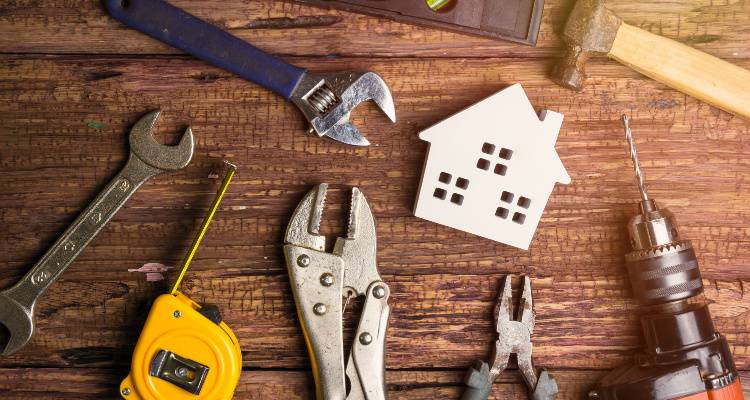How to Get Your Home Ready for a Storm

Preparing your Home for a Storm
If you carry out regular maintenance on your home, it will help reduce the risk of having to carry out a larger repair in the future. This is also true when preparing your home for a storm.
In the UK this doesn't normally mean boarding up windows but by carrying out the regular checks listed below you will be better prepared for bad weather and you will reduce long-term damage to your home that can lead to a more expensive to repair in the future or after stormy weather.
Storms can also create power cuts; check out our article on how to prepare for a power cut.
What to do Before the Storm
If you are aware of a storm coming, these are some simple steps you can take to minimise the risk of damage to yours or a neighbour's property.
Clearing your Garden
On behalf of the population – if you have a trampoline, please take it down and store it in the garage! You might think it is heavy, but high winds can whip them up into the air easily and carry them several houses away.

On a more serious note, check around your garden for anything you might normally leave out and place it securely in your garage or shed. Items like garden furniture, plant pots, BBQs or hanging baskets are best removed and put in a secure place in advance of a storm.
Secure your Fences
Check along your garden perimeter for any existing damage or weak spots in your fence. If you can't repair it ahead of the storm, remove it and store it in a secure location for repair after the storm.
This will save you having to replace the whole panel, as it is likely to be further damaged by strong winds and cause damage to other areas of your property.
Stow Away your Bins
We all have multiple wheelie bins and crates to put our recycling in. Often, these bins are just left in the garden or down an alley, out of sight and out of mind. Building a bin shed will help stop your bins from blowing down the street in strong winds.

You could hire a carpenter or handyman to build you a storage area that will keep them secure, or alternatively, you will need to put them inside a shed or garage to save them blowing away when a storm comes.
Trim your Bushes and Trees
Cut back your garden before a storm arrives. Weak branches or shallow-rooted trees can be blown over and cause unexpected damage to your home. Contact a local gardener or tree surgeon to help make sure your garden is storm ready.
External House Checks Before a Storm
When you have secured everything in your garden by putting anything moveable into your garage or garden shed, it's time to carry out some external checks on your house.
Checking that the external areas of your house are in a good state of repair and as ready as you can be for the storm is good practice and can help reduce the risk of damage to your property.
Check your Roof
Check for broken tiles that may need replacing to prevent any heavy rain getting inside your home. Also check there are no loose tiles, as these can fly off the roof and cause considerable damage.
If you are not able to replace broken tiles in time, a building contractor may be able to build temporary protection that should mitigate against further damage during the storm.
Windows and Doors Check
Do your windows or doors shut correctly and fully? Read our post on double glazing repairs where we talk about the six signs that your windows are worn out.

If your windows are fragile or in need of replacement, and the storm is going to be very bad, you may want to board them up to prevent heavy rain and wind causing extra damage. Damaged windows can also cause your home to lose heat quickly, so it's worth the long-term investment in quality windows.
Prepare Against Flood Damage
If you are in an area that is at risk of flooding, or you think it may be at risk, placing sandbags in front of your door will help deflect water away from your home should the water level rise.
Have on hand buckets or bowls. Should you be unfortunate enough to get a leak, these are handy to catch any drips coming inside your home while you wait for a repair. Be sure to check them and empty them regularly, so they don't overflow.
Inside your Home During a Storm
We feel safe and secure inside our homes and that's the way it should be. Your home is a place to shelter away from the storm and harsh weather conditions. These tips will help protect you and the inside of your home further during stormy weather conditions.
Food and Water
Always make sure you have plenty of the basic supplies available in your home. We normally take fresh water for granted in the UK, but during severe floods there can be problems with the water supply, as there is a higher risk of contamination.

If there is a risk of flooding in your area, keep food and water supplies upstairs if you can, keeping them away from possible contamination and water damage.
Remember too, if your power goes off, your freezer will stop working, so it's best not to overstock your freezer during this period. Avoid the temptation to stockpile frozen and perishable food and if you do lose power keep the freezer and fridge door closed at all times, so that they remain as cold as possible inside and you minimise the risk of damage to food.
Safety Kit
You have food, you have water, but a few other basics that are worth making sure you have to hand are:
- First aid kit (ensure that any plasters and analgesics are within date)
- Torch (with spare batteries)
- Phone with charge
- Chargers for your phone (a power bank is ideal if you expect the electricity to be affected)
Protecting your Valuables
General items in our homes can be replaced, but there are some items you are just not able to replace. Make an inventory of all the valuable items in your home, taking pictures and making note of any serial numbers and any receipts. This information can then be stored in the cloud where the data is kept securely and easily accessed if needed.

It's also a good idea to keep a scanned copy of any important documents like insurance, driving licence and passport. This will make life a little easier if you do have to make a claim on your insurance, or if the originals are damaged by flood or fire. You will have easy access to the information you need to get your items and documents replaced quicker.
Placing precious items and electronics (phone or laptop) in waterproof bags or containers will help protect them should you need to evacuate.
Prepare for Leaving
Have a small bag packed and ready to take with you if you need to leave your home. Nothing too heavy, as you may have to carry it above flood water. Your go-bag should contain a few days' worth of warm, clean and dry clothing and any small valuables you must take with you. You can also keep your safety kit in there.
Keep your clothes and valuables dry by putting them inside a sealed plastic bag (a dry-bag is ideal). This will mean you have something warm and dry to change into if you must walk through flood waters or heavy rain.
If you do have to leave your home, secure all the windows and doors the best you can before you go, as leaving your home vulnerable can invalidate some insurance policies. However, if you do have to evacuate in a hurry, the main thing is that you remain safe and don't return to your property until you are advised it is safe to do so.
What to do After a Storm
When the storm has passed, and it is safe to venture outside again, or return to your home you'll need to check if there has been any damage to your property. It's time to check and make any repairs needed.
Carry out the following checks:
- Any damage to perimeter walls or fences?
- Is anything missing from the garden?
- Did you gain/lose a trampoline?
- Put your pot plants back outside
- Check for any visible signs of damage to the roof
- Check inside your property for any damage
- Inspect the area around the windows
- Inspect inside your loft
- Contact your insurance company to make any claims
If you need help with any checks or fixing storm damage, post a job and get in contact with local tradespeople with MyJobQuote.
Last updated by MyJobQuote on 11th February 2020.







